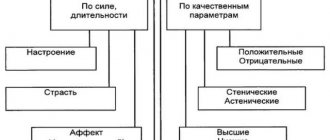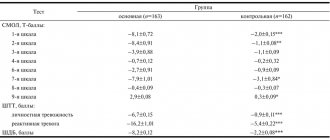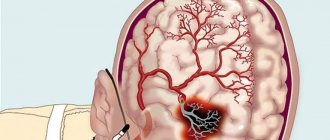Emotionally unstable (labile) personality disorder is characterized by increased excitability, impulsivity, low ability to self-control and emotional imbalance. Like other personality disorders, it is a character pathology (“severe character”) rather than a disease. An experienced psychotherapist can help with the disorder.
Important
A “difficult character”, the inability to cope with one’s emotions is a reason to seek help from a psychotherapist.
Another name for aggressive, epileptoid, excitable, explosive personality disorder. Doctors sometimes treat it as two separate disorders—impulsive disorder and borderline personality disorder.
A common characteristic of people with both types of emotionally unstable personality disorder is that they have difficulty controlling themselves and obeying norms and rules due to poor self-control and impulsivity. Personality traits make it difficult to establish and maintain contacts with others. Treatment with a psychotherapist for such people is an opportunity to accept the characteristics of their psyche and learn to live in harmony with others.
Emotionally volitional disorders in children.
The formation of the emotional-volitional sphere is one of the most important conditions for the formation of a child’s personality, whose experience is continuously enriched. The development of the emotional sphere is facilitated by family, school and life, which surrounds and constantly influences the child. Emotions play a significant role from the very beginning of a baby’s life, serve as an indicator of his relationship with his parents, and help him learn and respond to the world around him. Currently, along with general health problems in children, experts note with concern the increase in emotional-volitional disorders, which result in more serious problems in the form of low social adaptation, a tendency to antisocial behavior, and learning difficulties.
Hyperkinetic disorder
Develops at an early age. Determined by excessive activity, difficulty concentrating, especially regarding intellectual tasks. The children's activities are poorly organized: they grab onto a new task without finishing the previous one.
Restless, restless, easily distracted by extraneous stimuli. Therefore, it is difficult for a hyperactive student to sit in school classes. He is lost in his own dreams and is inattentive. Learning problems make it difficult to learn new knowledge, causing delayed cognitive development.
Impulsivity is manifested by thoughtless, unexpected actions, sometimes of a dangerous nature. Children run out onto the roadway, climb onto roofs, and play with flammable objects. Impulsivity is also expressed in tactless, inappropriate language. The mood changes quickly. Patients are quick-tempered and unbalanced.
Subsequently, such children, rejected by their environment, become aggressive, express protest, and are involved in illegal acts.
Aggression in children.
Let's talk about the most common sign of this disorder - aggression in a child, let's look at it in detail: The cause of aggression in children. Where does a child's aggression come from? Signs of aggression in children. How is aggression treated in children? Manifestations of aggression can be in the form of demonstrative disobedience to adults, physical aggression and verbal aggression. Also, his aggression can be directed at himself; he can hurt himself, but more often his peers. The child becomes disobedient and with great difficulty succumbs to the educational influences of adults. Aggression in a child is expressed in poor self-control and lack of awareness of one’s actions. Children's aggression can be controllable and uncontrollable. Uncontrolled aggressiveness is harmful, just like uncontrollable fear, uncontrollable delight and any other uncontrollable emotion. Aggression is not appropriate in relationships between relatives and friends at school, except for comic aggressiveness, when aggressiveness is a game, both parties are interested in such a game, perceive it only as a game and enjoy it, accordingly, there is no physical violence in it. A child may repel others with remarks expressing contempt or impatience, or insolence, but most often there is hard tactile contact. Increased aggressiveness in children is one of the most pressing problems not only for doctors, teachers and psychologists, but also for society as a whole. The main distinguishing feature of aggressive children is their attitude towards their peers. Aggression in children is perhaps the most important problem, since the number of children with such behavior is growing rapidly from year to year.
Signs of aggression in children
A child can feel his emotions, but he is not always able to recognize them and understand the reasons for his behavior. But as a rule, parents notice too late that something is happening to their child. Often, signs of aggression in children are the actions they perform:
- They are hysterical, often for show.
- They don't admit their mistakes.
- They pinch.
- They are angry.
- They call names.
- They take away the toys. .
- They refuse to carry out orders.
- They get angry (stomping their feet and banging their hands).
- Spit
- They use offensive words.
- They beat their peers
- They swing at others.
- They are taking revenge.
If in a family parents suppress the child in every possible way when raising a child, the child simply begins to hide his feelings. But as we can guess, they don’t go anywhere, but accumulate like a snow globe and in the near future an “explosion of emotions” occurs. An aggressive child is often driven by fear. Such a child is either afraid to be left alone, he thinks that no one can love him, no one will invite him for a walk, etc. All children want to be interested in them, to be invited to any events, to be spoken with kind words. The same is desired by a child who simply does not yet understand that aggression pushes people away from him even more. Accordingly, if parents do not reach out to a child who shows aggression and anger, then he may think about what else to do to make his parents love him again.
Disharmonious disorders of mature personality
Disharmonious disorder of mature personality and behavior in adults (psychopathy) is an anomaly of personality development with a predominant deficiency in the emotional-volitional sphere, persistent disturbances in adaptation in behavior, starting in childhood and adolescence and persisting throughout subsequent life. This anomaly of character, leading in the structure of the personality, is characterized by a triad: the totality of violations, their persistence and severity to the level of social maladjustment . At the same time, the person with a disharmonious personality type and the people around him suffer. Subjects with personality disorders usually tend to refuse psychiatric help and deny the disorders observed in them.
In case of personality disorders, subjects are not exempt from criminal liability (in a forensic psychiatric examination), are recognized as unfit for military service, and there are restrictions on their choice of profession.
According to available data, the prevalence of these disorders is 2-5% among the adult population, 4-5% among those hospitalized in psychiatric hospitals, and the predominance of men among psychopathic personalities compared to women (2:1-3:1).
Causes
Genetic, biochemical and social factors predispose to the occurrence of disorders of mature personality and behavior in adults.
Genetic factors. Peculiarities of temperament (character), manifested from childhood, are more clearly visible in adolescence: children who are fearful in nature may subsequently exhibit avoidance behavior. Minor organic disorders of the central nervous system in children are subsequently most common in antisocial and borderline individuals.
Biochemical factors. Individuals with impulsive traits often experience increased levels of the hormones 17-estradiol and estrone. Low levels of platelet monoamine oxidase enzyme correlate to a certain extent with social activity. Dopaminergic and serotonergic systems have an activating effect on psychophysical activity. High levels of endorphins, helping to suppress the activation reaction, are found in passive, phlegmatic subjects.
Social factors. In particular, the discrepancy between the temperament (character) of a mother with anxiety traits and the educational approach leads to the development of increased anxiety in the child and a greater susceptibility to personality disorders than if he was raised by a calm mother.
Symptoms
Disharmony of personality and behavior manifests itself in several areas: in cognitive (providing human cognitive activity) - the nature of perception of the environment and oneself changes; in the emotional – the range, intensity and adequacy of emotional reactions (their social acceptability) changes; in the field of control of impulses and satisfaction of needs; in the sphere of interpersonal relationships - when resolving conflict situations, the type of behavior significantly deviates from the cultural norm, manifests itself in a lack of flexibility, insufficient adaptability in various situations. If in childhood there are pathocharacterological radicals (excessive excitability, aggressiveness, a tendency to run away and wander, etc.), then in adolescence their transformation into pathocharacterological personality formation can be observed, then in adulthood - into psychopathy. Here, a personality disorder diagnosis can be made from the age of 17.
Character accentuations are extreme variants of the norm, in which individual character traits are excessively enhanced. At the same time, there is selective vulnerability to certain mental influences with good and even increased resistance to others. At least 50% of the population of developed countries have accentuated character traits. The degree of severity of personality disorders (severe, pronounced, moderate) is determined by the degree of severity of compensatory mechanisms. Among the types of disorders of mature personality and behavior in adults, the following are distinguished.
Schizoid personality disorder, in addition to the general diagnostic criteria for psychopathy, is characterized by anhedonia, when little is enjoyable, emotional coldness, inability to show warm feelings or anger towards other people, poor response to praise and criticism, little interest in sexual contact with another person, increased preoccupation with fantasies, constant preference for solitary activities, ignoring social norms and conventions dominant in society, lack of close friends and trusted relationships.
Emotionally unstable personality disorder is characterized by a strong tendency to act impulsively, without regard for consequences, along with mood instability. There are two types of this personality disorder :
impulsive type with outbursts of cruelty and threatening behavior, especially in response to condemnation by others;
borderline type , which is characterized by a chronic feeling of emptiness, disorder and uncertainty of self-image, intentions and internal preferences, including sexual ones (a risk factor for the formation of sexual perversions), a tendency to be involved in intense and unstable relationships, excessive efforts to avoid solitude. If such individuals are left alone, there may be suicidal threats or acts of self-harm due to the low subjective value of life.
Hysterical personality disorder is characterized by theatricality of behavior, exaggerated expression of emotions, increased suggestibility, superficiality and lability of emotions, a tendency to mood swings, a constant desire for activities in which the individual is the center of attention, inadequate seductiveness in appearance and behavior, increased concern about one’s own physical attractiveness.
Anancastic (obsessive-compulsive) personality disorder is characterized by an excessive tendency to doubt and caution, preoccupation with details, rules, lists, order, organization or schedules; a desire for perfection that prevents completion of tasks; excessive conscientiousness; scrupulousness and inappropriate concern for productivity at the expense of pleasure and interpersonal connections; increased pedantry and adherence to social norms (conservatism); rigidity and stubbornness; insufficiently substantiated, the appearance of persistent and unwanted thoughts and desires.
Anxious (avoidant) personality disorder is characterized by a constant general feeling of tension and severe forebodings and ideas about one’s own social inadequacy, personal unattractiveness, and humiliation in relation to others; increased concern about criticism addressed to oneself, its reluctance to enter into relationships without guarantees of being liked; limited lifestyle due to the need for physical security; avoidance of social or professional activities for fear of being criticized or rejected.
Dependent personality disorder is characterized by actively or passively placing most of the decisions in one's life on others; subordination of one's own needs to the needs of other people on whom the patient depends and inadequate compliance with their desires; reluctance to make even reasonable demands on people on whom the patient is dependent; feeling uncomfortable or helpless alone due to excessive fear of not being able to live independently; fear of being abandoned by a person with whom there is a close connection and being left to oneself; limited ability to make day-to-day decisions without extensive advice and encouragement from others.
Dissocial personality disorder (antisocial psychopathy - “innate criminal type”) manifests itself as a callous indifference to the feelings of others; a rude and persistent position of irresponsibility and disregard for social rules and responsibilities; inability to maintain relationships in the absence of difficulties in their formation; extremely low tolerance to frustration, as well as a low threshold for the discharge of aggression, including violence; inability to feel guilt and benefit from life experiences, especially punishment; a pronounced tendency to blame others or put forward plausible explanations for one’s behavior, leading the subject to conflict with society.
Paranoid personality disorder is characterized by: excessive sensitivity to failures and rejections; the tendency to constantly be dissatisfied with someone; suspicion; a militantly scrupulous attitude towards issues related to individual rights, which does not correspond to the actual situation; renewed unjustified suspicions regarding the sexual fidelity of a spouse or sexual partner; a tendency to experience one’s increased significance, which is manifested by constantly attributing what is happening to one’s own account, and being caught up in unimportant “conspiracy” interpretations of events happening to a given person.
Diagnostics
It is placed on the basis of dynamic observation of the subject’s behavior and the results of psychological testing.
Treatment
Various methods of psychotherapy, in a state of decompensation, biological methods of therapy (neuroleptics, antidepressants, tranquilizers
Classifications of emotional disorders and their symptoms
The difficulty in identifying emotional-volitional disorders has resulted in the fact that a number of psychologists have formed different views on these types of disorders. For example, the scientist-psychologist G. Sukhareva noted that emotional disturbances at primary school age are often observed in children suffering from neurasthenia, which was characterized by excessive excitability.
Psychologist J. Milanich had a different idea about these disorders. He found that emotional-volitional disorders include 3 groups of emotional disorders;
1. Acute emotional reactions, which are characterized by the coloring of certain conflict situations, which manifested themselves in aggression, hysteria, reactions of fear or resentment.
2. A state of increased tension - anxiety, fearfulness, decreased mood.
3. Dysfunction of the emotional state, which manifested itself in a sharp transition from positive emotional phenomena to negative ones and also in the reverse order.
However, the most detailed clinical picture of emotional disorders was compiled by N.I. Kosterina. She divides emotional disorders into 2 large groups, which are characterized by an increase in the level of emotionality and, accordingly, a decrease in it.
The first group includes such conditions as:
1. Euphoria, which is characterized by an inadequate increase in mood. A child in this condition, as a rule, has increased impulsiveness, impatience and a desire for dominance.
2. Dysphoria is the opposite form of euphoria, characterized by the manifestation of such emotions as anger, irritability, aggressiveness. It is a type of depressive syndrome.
3. Depression is a pathological condition characterized by the manifestation of negative emotions and behavioral passivity. A child in this state feels depressed and sad.
4. Anxiety syndrome is a condition in which a child feels causeless anxiety and severe nervous tension. It is expressed in constant mood swings, tearfulness, lack of appetite, and increased sensitivity. Often this syndrome develops into a phobia.
5. Apathy is a serious condition in which the child feels indifferent to everything that happens around him, and is also characterized by a sharp decrease in initiative functions. Most psychologists argue that the loss of emotional reactions is combined with a decrease or complete loss of volitional impulses.
6. Paratamia is a characteristic disorder of the emotional background, in which the experience of one specific emotion is accompanied by external manifestations of completely opposite emotions. Often observed in children suffering from schizophrenia.
The second group includes:
1. Attention deficit hyperactivity disorder, characterized by symptoms such as motor disorientation and impulsivity. It follows that the key signs of this syndrome are distractibility and excessive motor activity.
2. Aggression. This emotional manifestation is formed as part of a character trait or as a reaction to environmental influences. In any case, the above violations need correction. However, before correcting pathological manifestations, the main causes of the disease are first identified.
Diagnosis of disorders
For subsequent therapy of disorders and its effectiveness, timely diagnosis of the child’s emotional development and its disorders is very important. There are many special methods and tests that assess the development and psychological state of a child, taking into account his age characteristics.
Diagnosis of preschool children includes:
1. Diagnosis of anxiety level and its assessment
2. Study of psycho-emotional state.
3. Luscher color test.
4. Study of self-esteem and personal characteristics of the child.
5. Study of the development of volitional qualities.
Seeking psychological help is necessary if a child experiences certain difficulties in learning, communicating with peers, behavior, or has certain phobias.
Parents should also pay attention if the child experiences any emotional experiences, feelings, and also if his condition is characterized as depressed.









